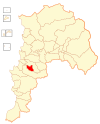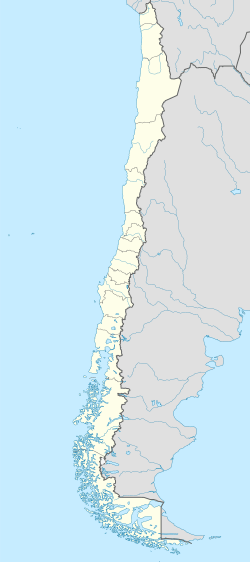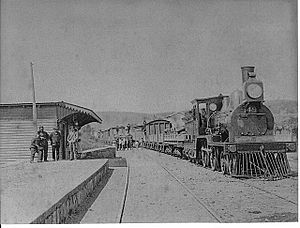Villa Alemana facts for kids
Quick facts for kids
Villa Alemana
|
||||||
|---|---|---|---|---|---|---|
|
||||||
| Country | Chile | |||||
| Region | Valparaíso | |||||
| Province | Marga Marga | |||||
| Founded | November 8, 1894 | |||||
| Government | ||||||
| • Type | Municipality | |||||
| Area | ||||||
| • Total | 96.5 km2 (37.3 sq mi) | |||||
| Elevation | 143 m (469 ft) | |||||
| Population
(2012 Census)
|
||||||
| • Total | 116,097 | |||||
| • Density | 1,203.1/km2 (3,116.0/sq mi) | |||||
| • Urban | 94,802 | |||||
| • Rural | 821 | |||||
| Sex | ||||||
| • Men | 45,868 | |||||
| • Women | 49,755 | |||||
| Time zone | UTC-4 (CLT) | |||||
| • Summer (DST) | UTC-3 (CLST) | |||||
| Area code(s) | (country) 56 + (city) 32 | |||||
| Website | Official website: https://web.archive.org/web/20120616065706/http://www.villa-alemana.cl/ | |||||
Villa Alemana is a city and commune in the central part of Chile. Its name means "German Village" in English. The city was started in 1896 by people who moved there from Italy and Germany. Villa Alemana is part of a larger city area called Greater Valparaiso.
The flag of Villa Alemana is special because it includes parts of the German flag.
Contents
History of Villa Alemana
Villa Alemana began when Chile was building its railway system. The weather here is so mild that people call it "The City of Eternal Youth." Another nickname is "City of the Mills."
Long ago, this area was mostly open fields. There were also small vineyards, trees, and many hawthorn trees. A man named Don Buenaventura Joglar had an idea to buy land here. He divided the land into smaller pieces. He named the new settlement Villa Alemana because German immigrants were the first to buy these plots.
The city was officially founded on November 8, 1894. It was first called Viña Miraflores.
On January 5, 1918, Villa Alemana became its own commune, which is like a local government area. Later, in 1928, it joined with a nearby town called Quilpué. But on June 7, 1933, Villa Alemana became a separate commune again. Today, many people who live in Villa Alemana travel to work in Viña del Mar and Valparaíso.
Population and Area
According to a 2002 study, Villa Alemana covers an area of about 96.5 square kilometers (about 37 square miles). It had 95,623 people living there at that time. Out of these, 45,868 were men and 49,755 were women.
Most of the people, about 99.1%, lived in city areas. Only a small number, about 0.9%, lived in country areas. The population of Villa Alemana grew a lot between 1992 and 2002, by about 33.4%.
How Villa Alemana is Governed
Villa Alemana is a commune, which is a local government area in Chile. It is managed by a municipal council. The head of the council is the alcalde, or mayor, who is chosen by voters every four years. The current mayor for 2021-2024 is Javiera Toledo Muñoz.
The council also has eight other members who help make decisions for the city. They are:
- Edith Alvear Guerra
- Cecilia Quinteros Díaz
- Marcelo Valderrama Magna
- Guillermo Barra Arancibia
- Kesia Navarro Cueto
- Marcelo Góngora Carvajal
- María Fernanda Ternicier Andrades
- Alonso Fierro Reguera
Villa Alemana is also part of larger electoral areas. These areas choose people to represent them in the national government.
Education
In the past, Villa Alemana had a German school called Deutsche Schule Villa Alemana.
Climate
| Climate data for Villa Alemana (Penablanca) | |||||||||||||
|---|---|---|---|---|---|---|---|---|---|---|---|---|---|
| Month | Jan | Feb | Mar | Apr | May | Jun | Jul | Aug | Sep | Oct | Nov | Dec | Year |
| Mean daily maximum °C (°F) | 27.2 (81.0) |
27.2 (81.0) |
26.3 (79.3) |
22.4 (72.3) |
19.6 (67.3) |
17.1 (62.8) |
16.0 (60.8) |
17.4 (63.3) |
19.9 (67.8) |
22.2 (72.0) |
24.5 (76.1) |
26.9 (80.4) |
22.2 (72.0) |
| Daily mean °C (°F) | 19.8 (67.6) |
19.1 (66.4) |
17.8 (64.0) |
14.8 (58.6) |
12.8 (55.0) |
10.6 (51.1) |
9.7 (49.5) |
10.3 (50.5) |
12.9 (55.2) |
15.0 (59.0) |
17.0 (62.6) |
18.8 (65.8) |
14.9 (58.8) |
| Mean daily minimum °C (°F) | 13.8 (56.8) |
13.8 (56.8) |
12.2 (54.0) |
9.7 (49.5) |
8.2 (46.8) |
6.1 (43.0) |
5.2 (41.4) |
5.3 (41.5) |
8.3 (46.9) |
10.2 (50.4) |
11.8 (53.2) |
12.8 (55.0) |
9.8 (49.6) |
| Average precipitation mm (inches) | 0.7 (0.03) |
4.1 (0.16) |
2.0 (0.08) |
29.7 (1.17) |
66.1 (2.60) |
91.2 (3.59) |
79.2 (3.12) |
83.4 (3.28) |
9.2 (0.36) |
16.2 (0.64) |
0.2 (0.01) |
0.1 (0.00) |
382.1 (15.04) |
| Average relative humidity (%) | 66 | 68 | 70 | 77 | 80 | 82 | 82 | 82 | 80 | 76 | 70 | 66 | 75 |
| Source: Bioclimatografia de Chile | |||||||||||||
Sister Cities
Villa Alemana has a special connection with another city far away. This is called a "sister city" relationship.
See also
 In Spanish: Villa Alemana para niños
In Spanish: Villa Alemana para niños






